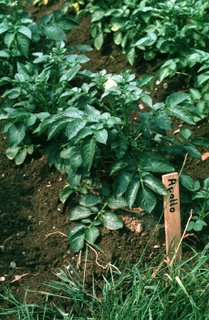botany of desire
New favorite comix and comic artists for the new year:
Dan Clowes' Ice Haven
R. Kikuo Johnson's Night Fisher (this recommendations comes from Kai-Ming--you can sign up for her comics e-newsletter at Publishers Weekly
Paper Rad (see link on the right hand column)
 Last fall our plants professor recommended that we read Michael Pollan's The Botany of Desire over winter break (since no one has time to read during the semester). Pollan writes one chapter each on the apple, the tulip, marijuana, and the potato, looking at how these plants have thrived by adapting themselves into our lives and altering our behavior. There are some great passages about commercial agriculture, the Russet Burbank (the variety McDonald's uses for its french fries) and the NewLeaf, Monsanto's genetically engineered potato:
Last fall our plants professor recommended that we read Michael Pollan's The Botany of Desire over winter break (since no one has time to read during the semester). Pollan writes one chapter each on the apple, the tulip, marijuana, and the potato, looking at how these plants have thrived by adapting themselves into our lives and altering our behavior. There are some great passages about commercial agriculture, the Russet Burbank (the variety McDonald's uses for its french fries) and the NewLeaf, Monsanto's genetically engineered potato:
"The typical potato grower stands in the middle of a bright green circle of plants that have been doused with so much pesticide that their leaves wear a dull white chemical bloom and the soil they're rooted in is a lifeless gray powder. Farmers call this a 'clean field,' since, ideally, it has been cleansed of all weeds and insects and disease--of all life, that is, with the sole exception of the potato plant. A clean field represents a triumph of human control, but it is a triumph that even many farmers have come to doubt. To such a farmer a new kind of potato that promises to eliminate the need for even a single sparying of chemicals is, very simply, an economic and environmental and perhaps even psychological boon.
I asked [farmer] Danny Forsyth to walk me through a season's regimen, the state of the art in the control of a potato field. Typically it begins early in the spring with a soil fumigant; to control nematodes and certain diseases in the soil, potato farmers douse their feilds before planting with a chemical toxic enough to kill every trace of microbial life in the soil. Next Forsyth puts down an herbicide--Lexan, Sencor, or Eptam--to 'clean' his field of all weeds. Then, at planting, a systemic insecticide--such as Thimet--is applied to the soil. This will be absorbed by the young seedlings and kill any insect that eats their leaves for several weeks. When the potato seedlings are six inches tall, a second herbicide is sprayed on the field to control weeks.
Dryland farmers like Forsyth farm in the vast circles I'd seen from the sky; each circle, defined by the radius of the irrigation pivot, typically covers an area of 135 acres. Pesticides and fertilizer are simply added to the irrigation system, which on Forsyth's farm draws water from (and returns it to) the nearby Snake River. Along with their ration of water, Forsyth's potatoes receive weekly sprayings of chemical fertilizer. Just before the rows close--when the leaves of one row of plants meet those of the next--he begins spraying Bravo, a fungicide, to control late blight, the same fungus that caused the Irish potato famine and is once again today the potato grower's most worrisome threat. A single spore can infect a field overnight, Forsyth said, turning the tubers into a rotting mush. Beginning this month, Forsyth will hire a crop duster to spray for aphids at fourteen-day intervals. The aphids are harlmess in themselves, but they transmit the leaf roll virus, which causes 'net necrosis' in Russet Burbanks, a brown spotting of the potato's flesh that will cause a processor to reject a whole crop. Despite all his efforts to control it, this happened to Forsyth just last year. Net necrosis is purely cosmetic defect, yet because McDonald's believes--with good reason--that we don't like to see brown spots in our french fries, farmers like Danny Forsyth must spray their fields with some of the most toxic chemicals now in use, including an organophosphate called Monitor.
Beginning this month, Forsyth will hire a crop duster to spray for aphids at fourteen-day intervals. The aphids are harlmess in themselves, but they transmit the leaf roll virus, which causes 'net necrosis' in Russet Burbanks, a brown spotting of the potato's flesh that will cause a processor to reject a whole crop. Despite all his efforts to control it, this happened to Forsyth just last year. Net necrosis is purely cosmetic defect, yet because McDonald's believes--with good reason--that we don't like to see brown spots in our french fries, farmers like Danny Forsyth must spray their fields with some of the most toxic chemicals now in use, including an organophosphate called Monitor.
'Monitor is a deadly chemical,' Forsyth told me; it is known to damage the human nervous system. 'I won't go into a field or four or five days after it's been sprayed--not even to fix a broken pivot.' That is, Forsyth would sooner lose a whole circle to drought than expose himself or an employee to this poison.
Leaving aside the health and environmental costs, the economic cost of all this control is daunting. A potato farmer in Idaho spends roughly $1,950 an acre (mainly on chemicals, electriciy, and water) to grow a crop that, in a good year, will earn him maybe $2,000. That's how much a french-fry processor will pay for the twenty tons of potatoes a single Idaho acre can yield. It's not hard to see why a farmer like Forsyth, struggling against such tight margins and heartsick over chemicals, would leap at a NewLeaf...
Before driving out to have a look at his fields, Forsyth and I got onto the subject of organic agriculture, about which he had the usual things to say ('That's all fine on a small scale, but they don't have to feed the world') and a few things I never expected to hear from a conventional farmer. 'I like to eat organic food, and in fact I grow a lot of it at the house. The vegetables we buy at the market we just wash and wash and wash and wash. I'm not sure I should be saying this, but I always plant a small area of potatoes without any chemicals. By the end of the season, my field potatoes are fine to eat, but any potatoes I pulled today are probably still full of systemics. I don't eat them.'
(P.S. Just so you don't think Pollan is a big Monsanto fan: he describes the risks of introducing NewLeafs, which are genetically altered to include a bacteria Bt that makes it resistant to blight, and writes well about how, at best, genetic engineering is just a stop-gap measure to the larger problems created by commercial agriculture and the consumption patterns that drive it.)


0 Comments:
Post a Comment
<< Home